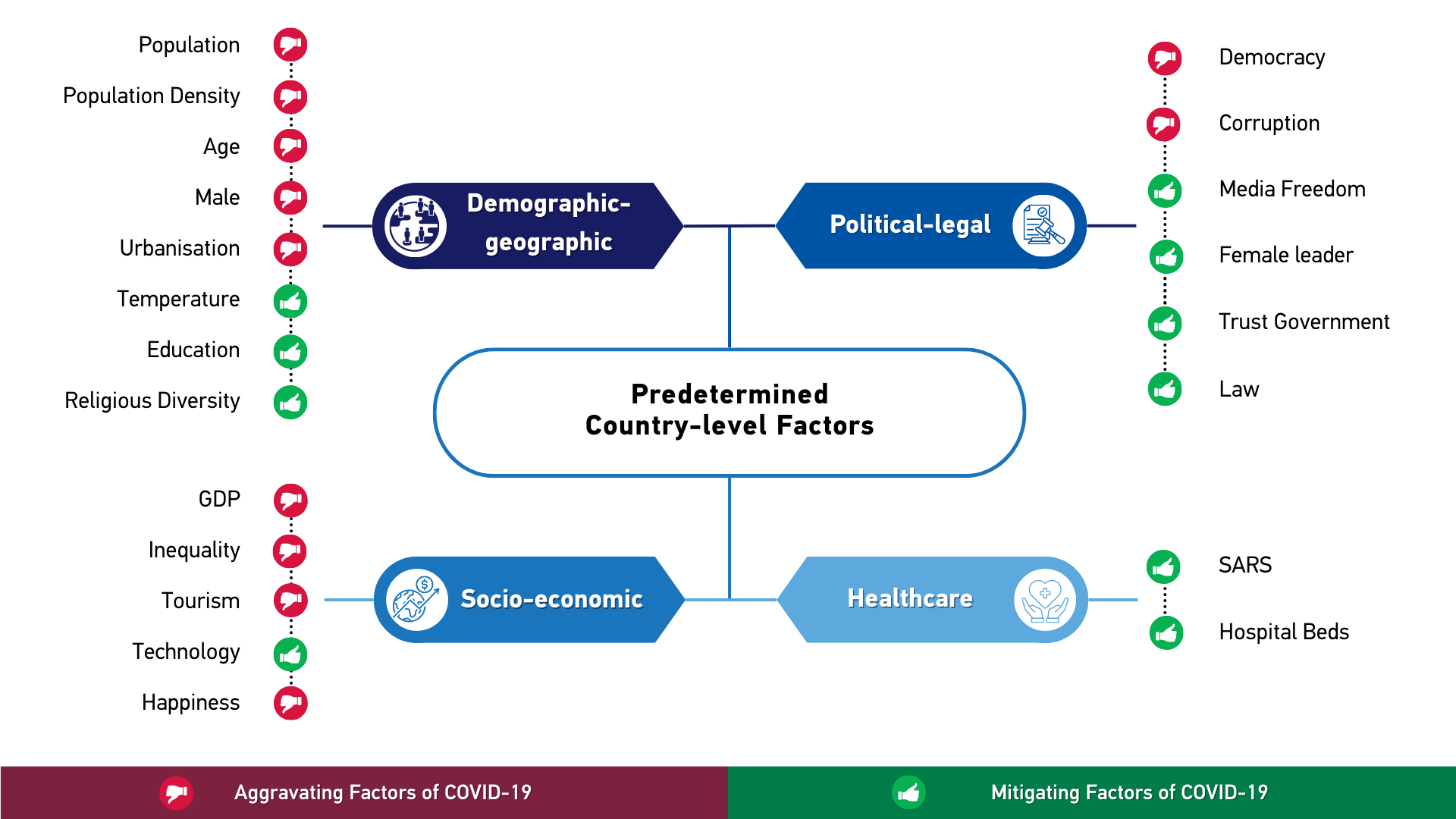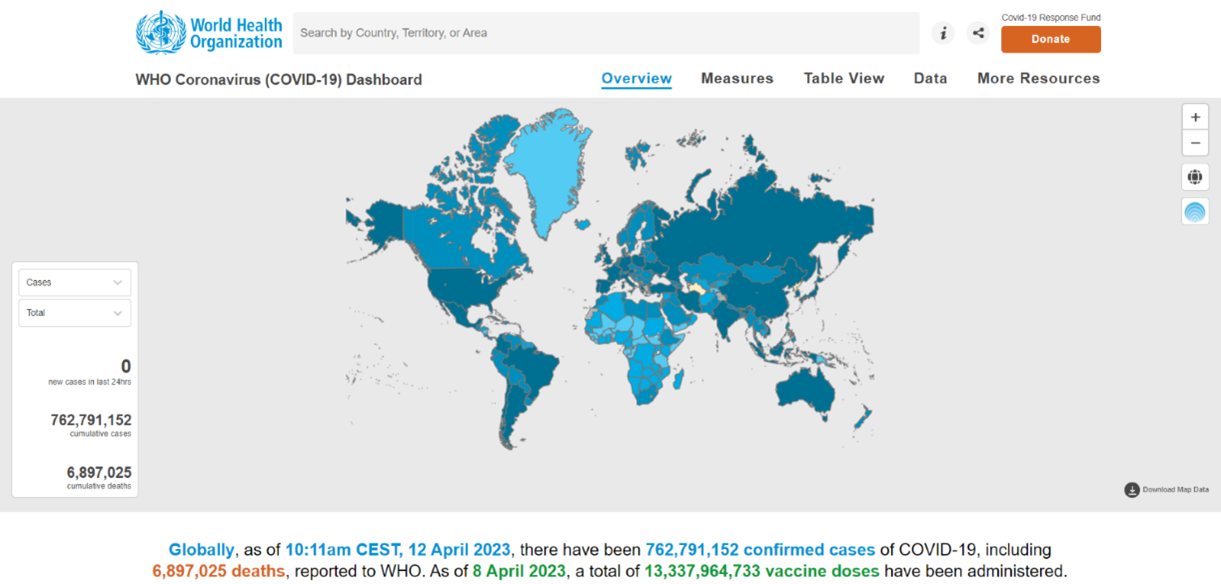The Determinants of COVID-19 Morbidity and Mortality Across Countries

Could we have prevented the catastrophic scale of the coronavirus pandemic? Declared a global pandemic, the coronavirus (COVID-19) outbreak affected almost all countries and caused significant loss of life, health, and economic output. The World Health Organization (WHO) reported over 760 million confirmed cases and 6.8 million deaths globally as of April 2023 (WHO, 2023). An independent global panel stated that millions of lives could have been saved if only countries had been more responsive (Boseley, 2021).
As prevention is better than cure, a group of researchers came together to analyse the characteristics of countries impacted by COVID-19 and each country's policy response to contain the virus. Hence, Professor Simba, Xin Chang (Nanyang Technological University), Professor Dianna Chang (Singapore University of Social Sciences), Professor Yu He (China University of Geosciences), and Professor Kelvin Tan (The University of Queensland) wrote the paper, ‘The Determinants of COVID-19 Morbidity and Mortality Across Countries’.
“We started the project during the darkest period of the pandemic when many countries, including Singapore, adopted strict lockdowns and citizens were living in fear and isolation. Through our research, we hope that such crises can be avoided in the future, or if they are unavoidable, countries can better manage such health crises to prevent losses,” said Professor Simba.
Predetermined country-level factors
The paper identifies 21 country-level factors determined prior to the outbreak, as policymakers cannot quickly adjust these factors within a relatively short period. To analyse the effects these factors had on COVID-19, the researchers sampled 91 countries and gathered data on the number of cases and deaths weekly between January and December 2020 (before the implementation of vaccination programs) from the John Hopkins Coronavirus Resource Center. Most importantly, this research aims to explain differences in morbidity and mortality across countries to prevent future crises from spiralling out of control.

Visual chart of predetermined country-level factors
To explain the cross-country variations in the number of cases and deaths, the paper examines four key dimensions: demographic-geographic, political-legal, socio-economic, and healthcare factors. With the number of COVID tests as a control variable, the researchers ran a regression analysis to compare all countries concurrently. From the results, they categorised the 21 determinants into two groups: aggravating factors, which increase infections and deaths; and mitigating factors, which reduce them.
Among the demographic-geographic factors, the researchers found that population, male-to-female ratio, population density, age and urbanisation aggravated the severity of COVID-19, while education, temperature and religious diversity mitigated the impact of the pandemic. For the political-legal factors, democracy and political corruption are aggravating factors, while female leadership, law (strength of legal systems), media freedom and trust in government reduced infections and deaths.
Among the socio-economic factors, the GDP per capita, income inequality, happiness (life satisfaction) and tourism led to worse outcomes, whereas technological advancement increased morbidity but reduced mortality. Lastly, for healthcare factors, countries that had experienced SARS (severe acute respiratory syndrome) and the existence of hospital beds (healthcare infrastructure) allowed them to better combat the pandemic.

Screenshot taken from the WHO website
The good, the bad and the ugly
With technological advancement and media reports, the pandemic has allowed us to observe the situation in each country through live updates and see how different countries responded to the outbreak. For countries to better manage the pandemic, let's look at why certain factors aggravated or mitigated the COVID-19 situation.
Firstly, it was found that males were more exposed to infectious diseases than females. A probable reason is that males are more active in the labour market, which requires human interaction. Furthermore, studies show that men are reluctant to comply with preventive measures such as wearing face masks, thus making them vulnerable to contracting COVID-19. Similarly, income inequality aggravates COVID-19, as low-income groups are prone to contracting diseases. For instance, the poor are usually low-skilled workers whose work requires them to be physically present (e.g., factories and construction sites) and use public transport more often than others. Therefore, the government should address such inequalities and ensure that the vulnerable are better protected.
On the other hand, religious diversity (the number and size of religious groups in a country) helps prevent infectious diseases. Prior studies show that religions help people develop resilience and that they obtain social support from their religious groups. Hence, religion allows one to stay disciplined and facilitates information sharing on how to live during the pandemic. Interestingly, the researchers also found that female political leaders perform better than their male counterparts in pandemic control. It was reported that countries with female leaders, such as New Zealand and Germany, responded better to handling the pandemic and containing the virus countrywide.
“We argue that female leaders have generally acted more quickly and decisively as they demonstrated greater risk aversion toward suffering and deaths. These female leaders have also consistently taken a broader view to consider the impact of COVID-19 on society and are more open to innovative thinking.”, remarked Professor Dianna on how female leaders steered the crisis.

What can we learn from the COVID-19 pandemic?
As individuals, it is important that we stay resilient and disciplined amidst the pandemic. The importance of education is also critical as it allows the population to stay more informed and make better decisions, thus mitigating the risks of COVID-19.
Drawing on Singapore’s way of handling the pandemic, the government stepped up on community hygiene, safe distancing, and vaccination measures. For instance, a vaccination music video fronted by an iconic television character, Phua Chu Kang, went viral for using humour to educate the public on the importance of getting vaccinated. Moreover, the implementation of Singapore’s contact tracing app, TraceTogether, enabled citizens to identify whether they had been exposed to the virus through close contact. This illustrated how the media and adoption of technologies enabled citizens to successfully navigate the pandemic and avoid the risk of contracting disease.
During the pandemic, the leaders and governments of each country also had a huge role to play in reducing cases and deaths, especially in heavily populated countries. The researchers proposed that governments should balance the efficient utilisation of urban spaces and ensure sufficient social spaces for disease prevention in the layout and design of housing and communities. In 2020, it was reported that nearly half of Singapore’s migrant workers contracted COVID-19, most of which occurred in cramped dormitories (Reuters, 2020). The government then locked down the dormitories and placed the workers in temporary community facilities, where they received medical care. This showed how significant it is for governments to also invest in disease prevention aside from treatment.
“Our study concludes that multiple factors are required to explain a country’s COVID-19 performance, and countries need to monitor and develop multi-dimensional capacities to stay ready for a future pandemic. We hope that policymakers and healthcare experts may consider utilising the mitigating factors to further develop risk-preparedness and strengthen social solidarity in health crises.”, Professor Simba commented on the takeaway messages from his research.
Note: This research paper was published by scientific reports, on 7 April 2022.
References
World Health Organization (2023). WHO Coronavirus (COVID-19) Dashboard.
https://covid19.who.int/
Boseley, S. (2021, May 12). Covid pandemic was preventable, says WHO-commissioned report. The Guardian. https://www.theguardian.com/world/2021/may/12/covid-pandemic-was-preventable-says-who-commissioned-report
Reuters (2020, December 15). Half of Singapore's migrant workers in dormitories have had COVID-19. REUTERS. https://www.reuters.com/business/healthcare-pharmaceuticals/half-singapores-migrant-workers-dormitories-have-had-covid-19-2020-12-15/
Xin Chang, Simba is a Professor of Finance at Nanyang Business School and Associate Dean (Research) overseeing PhD programs and research activities at Nanyang Business School. He specializes in corporate Finance, especially capital structure, mergers and acquisitions, and stock valuation. He had taught various courses to undergraduate, honours, master, and PhD students at HKUST, the University of Melbourne, the University of Cambridge, and NTU.
This research paper is a joint work with Dr Dianna Chang (Singapore University of Social Sciences), Professor Yu He (China University of Geosciences) and Professor Kelvin Tan (The University of Queensland).

